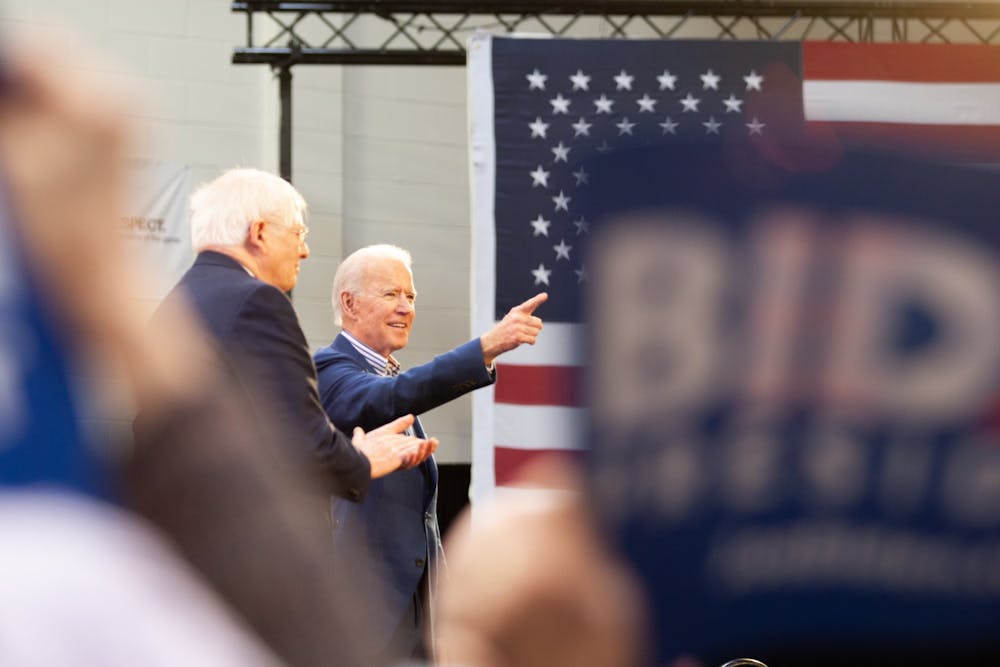President Donald Trump had the lead in North Carolina over former Vice President Joe Biden as of midnight, leading by 1.39 percent, according to unofficial results.
117,000 absentee ballots in North Carolina have yet to be returned, according to the N.C. State Board of Elections. This is larger than the number of votes Trump has over Biden as of midnight on Tuesday, which was 76,380.
In North Carolina, absentee ballots received by Nov. 12 will be counted in the election.
While those who vote absentee tend to lean Democratic, Bob Phillips, executive director of Common Cause N.C., said it's hard to say whether these uncounted absentee ballots will make a difference in the election.
Republicans won races down the ballot, according to unofficial North Carolina results. Incumbent U.S. Sen. Thom Tillis, R-N.C., was leading against Democratic challenger Cal Cunningham by 1.78 percent as of midnight on Wednesday.
Many Republican council of state candidates, such as N.C. agriculture commissioner candidate Steve Troxler, state superintendent candidate Catherine Truitt and treasurer Dale Folwell were also projected to win, according to unofficial results.
Phillips said Trump's lead in North Carolina could be attributed to a lack of youth voter turnout in the state. He said although youth voter turnout was higher than in the 2016 election, many voters under 39 were not performing to what registration levels in North Carolina looked like.
"Unfortunately, that is not unusual," he said. "Younger voters vote in lower numbers than older voters. And it looks like an election that is no different from others, as far as that matter goes"
Charles Coble, a precinct co-chairperson for East Franklin, said the precinct has been struggling to get students to vote. He said although almost all of the adults in the precinct have voted, as of Monday, over 1,000 students in the precinct hadn't voted.
He said he thinks the pandemic has caused confusion among college-aged voters.
"Once upon a time, there were in dormitories and they were nearby and you could grab them on campus and on the streets downtown, but now downtown Chapel Hill is empty," he said. "Now finding the students to be able to encourage them to vote is challenging."
Coble compared this election to 2008, when former President Barack Obama won North Carolina by about 14,000 votes. He said this was because of students in the UNC System, at schools like UNC-Chapel Hill, N.C. State University, Appalachian State University and UNC-Pembroke.
To get the day's news and headlines in your inbox each morning, sign up for our email newsletters.
"Obama only won those counties because of students and now the students aren’t on campuses or in the dorms — we’re not exactly sure where they are," he said. "For a precinct chair with 1,400 students in his precinct, that leaves me feeling very vulnerable in terms of are we really gonna get a turnout."
North Carolina is a swing state. Jason Roberts, a UNC political science professor and Orange County Board of Elections member, said if either presidential candidate is winning by three or four percentage points, that bodes well for them throughout the country.
But he said if either candidate is winning by a close margin, it doesn’t say a lot about how other states will look.
Election results for North Carolina will be certified Nov. 24.
Phillips said with Trump projected to win other sunbelt states like Florida and potentially Georgia, the presidential race might come down to Pennsylvania, which unlike North Carolina, could not begin counting absentee ballots until Election Day.
"There could be some real drama," he said. "It could all come down to that one state Pennsylvania, and we might be, you know, waiting for the next two or three days to see who wins that state, and that might then be the determinator of who wins the White House."
Audrey Selley contributed reporting.
@sonjarao
city@dailytarheel.com | @DTHCityState




